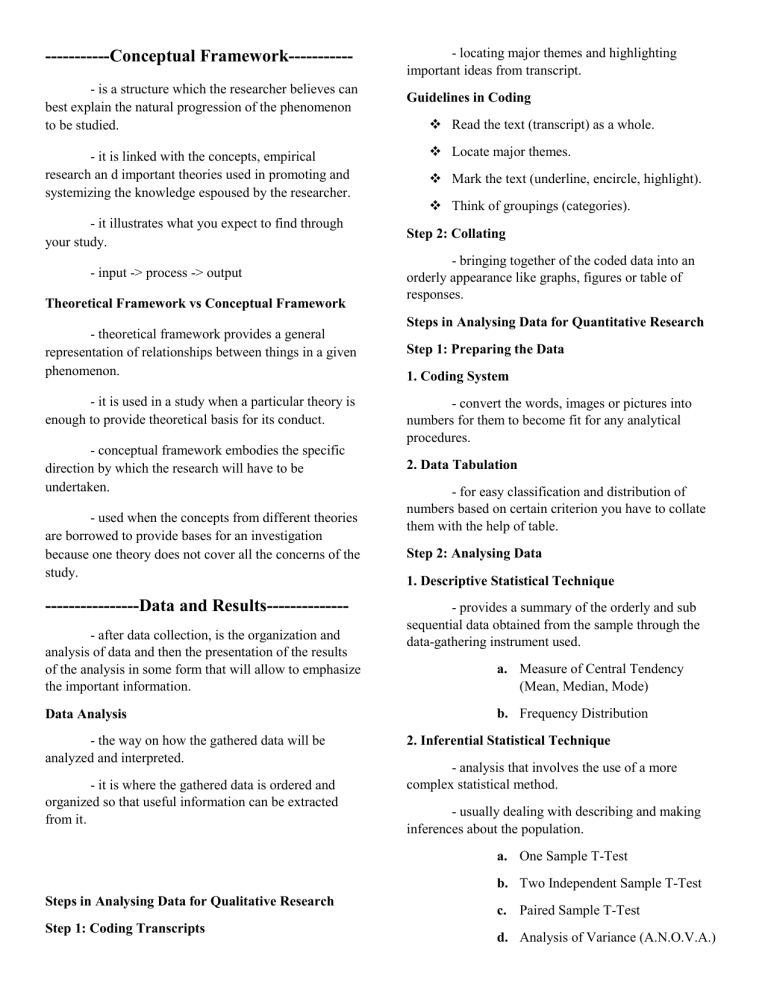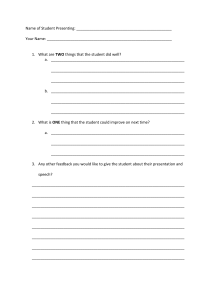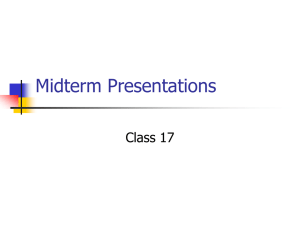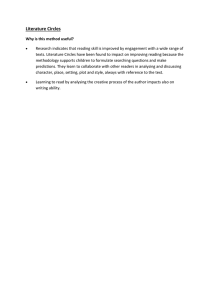
-----------Conceptual Framework----------- is a structure which the researcher believes can best explain the natural progression of the phenomenon to be studied. - it is linked with the concepts, empirical research an d important theories used in promoting and systemizing the knowledge espoused by the researcher. - it illustrates what you expect to find through your study. - input -> process -> output Theoretical Framework vs Conceptual Framework - theoretical framework provides a general representation of relationships between things in a given phenomenon. - it is used in a study when a particular theory is enough to provide theoretical basis for its conduct. - conceptual framework embodies the specific direction by which the research will have to be undertaken. - used when the concepts from different theories are borrowed to provide bases for an investigation because one theory does not cover all the concerns of the study. ----------------Data and Results-------------- after data collection, is the organization and analysis of data and then the presentation of the results of the analysis in some form that will allow to emphasize the important information. Data Analysis - the way on how the gathered data will be analyzed and interpreted. - it is where the gathered data is ordered and organized so that useful information can be extracted from it. - locating major themes and highlighting important ideas from transcript. Guidelines in Coding Read the text (transcript) as a whole. Locate major themes. Mark the text (underline, encircle, highlight). Think of groupings (categories). Step 2: Collating - bringing together of the coded data into an orderly appearance like graphs, figures or table of responses. Steps in Analysing Data for Quantitative Research Step 1: Preparing the Data 1. Coding System - convert the words, images or pictures into numbers for them to become fit for any analytical procedures. 2. Data Tabulation - for easy classification and distribution of numbers based on certain criterion you have to collate them with the help of table. Step 2: Analysing Data 1. Descriptive Statistical Technique - provides a summary of the orderly and sub sequential data obtained from the sample through the data-gathering instrument used. a. Measure of Central Tendency (Mean, Median, Mode) b. Frequency Distribution 2. Inferential Statistical Technique - analysis that involves the use of a more complex statistical method. - usually dealing with describing and making inferences about the population. a. One Sample T-Test b. Two Independent Sample T-Test Steps in Analysing Data for Qualitative Research Step 1: Coding Transcripts c. Paired Sample T-Test d. Analysis of Variance (A.N.O.V.A.) e. Person’s R Coefficient of Correlation f. Chi-Square g. Spearman’s Rho h. Regression Analysis Standard Deviation- is a measure that shows how spread out numbers are. -------------Summary of Findings------------ it provides a discussion for each of the findings and states how the findings are important or relevant based on the aim and scope of your study. Ways in Presenting Data - displays numbers in columns, it also condenses and classifies information to make comparisons between and among data and helps the readers grasp relationships that might be visible in prose. Guidelines in Terms of Styling and Formatting Tables Simplify the table data by just presenting those that will illustrate your point without distorting the data so you will not overwhelm the readers with numerous columns and rows. Do not write the word or abbreviation for the unit of measurement in every cell of the columns; rather write the abbreviation in parentheses in the column or row heading instead. Textual Presentation B. Charts - incorporates important figures in a paragraph of text. It allows us to direct the readers’ interest to vital information. - a graphical representation of data using symbols that are usually boxes, lines and arrows to show ranks, levels, procedures and classifications. Visual/Graphic Forms 1. Organizational Chart - allows the writer to condense and present his information in an aesthetically pleasing manner. ideas. Presenting Findings Visually 2. Flow Chart A. Titles - presents rankings, classifications and levels of - illustrates a process or direction of steps. - any visual aid you will use should feature a suitable title and should be numbered. C. Graphs B. Labels - a diagram which shows the relationship between variable quantities. - all illustrations which describe something should contain labels – words and phrases that name parts or sections of the things being described. C. Keys - the unusual area of an illustration which lists and describes the meaning of certain shades, colors or line styles. D. Positioning - illustrations should be placed after the point where they have been discussed and in case the explanation or discussion and the graphics cannot be placed in one page you should place the illustration at the top of the next page. Types of Visual/Graphic Forms A. Tables A. Circle Graph/Pie Graph - shows the relationship of the parts to the whole in percentages or proportions. B. Line Graph - shows trends and changes in data where the bottom grid scale represents time. - it can also show comparison if there is more than one line in the graph. C. Bar Graph - uses vertical and horizontal bars that compare amounts and quantities. D. Pictograph - is like a horizontal bar chart but instead of using bars, we use symbols or pictures to represent the magnitude. - the purpose of it is to get the attention of the reader. - the pictograph provides an overall picture of the data without presenting the exact figures and the choice for the symbol or picture should be appropriate for the type of data E. Statistical Graph - shows statistical data in geographical areas. Processing- is a series of actions or steps performed on data to verify and organize them for subsequent uses. --------------Chapter 5 & Others------------Summary - gives relevant information on how the study came to be. Conclusion - should be concise and engaging. - should clearly state the answer to the research questions and show the new knowledge contributed discovered through the research done. Recommendation - gives recommendation for future studies based on the ff. Attributes of the presented study: a. Number of Samples b. Scope and Limitation of the Study c. Future Problem/s or Question/s which may arise in the study Bibliography - lists all the references used in the study. Appendix/Appendices - includes relevant information like survey sheets, interview questions or questionnaires used in the course of the study. Curriculum Vitae - a detailed professional document highlighting a the researchers’ experience and accomplishments. Abstract - a brief summary of the research which is often used to help the reader quickly ascertain the paper's purpose. Acknowledgement - contains the writer’s foreword and the names of the people he is indebted to during the completion of the paper.



